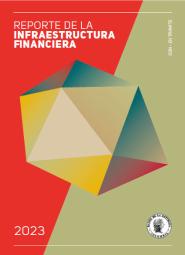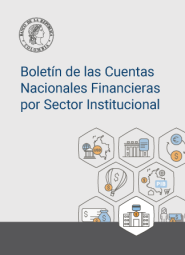Report of the Board of Directors to the Congress of Colombia, March 2024
Pursuant to Article 5 of Law 31 of 1992, the Board of Directors of Banco de la República (the Central Bank of Colombia) submits a report to the Honorable Congress of Colombia, informing about the performance of the economy and its outlook. This report is submitted twice a year, in March and July, within ten business days following the start date of the sessions of the Congress.
In 2023, the Colombian economy made progress in the macroeconomic adjustment required to achieve growth compatible with its productive capacity and external and price stability. This adjustment was reflected in the beginning of the convergence of inflation towards the target, which closed the year at 9.3%. This adjustment is an important step forward in the Board of Directors’ (BDBR) intention to drive inflation toward its target by mid-2025. Net foreign reserves increased and at the end of 2023 reached USD 59,608.3 million, and Banco de la República’s (the Central Bank of Colombia, Banrep) profit amounted to COP 9,226 billion.
 See the report (only available in Spanish)
See the report (only available in Spanish)
International Macroeconomic Environment
- IMF measurements indicate that global gross domestic product (GDP) growth was reduced from 3.5% in 2022 to 3.1% in 2023, and according to World Bank estimates, from 3.3% to 3.0%. This is due to the contractionary monetary policy of many central banks, fiscal tightening in most advanced countries, and high international uncertainty due to the conflicts between Russia and Ukraine and in the Middle East, among others.
- Global total inflation moderated in 2023 as a result of lower energy prices, normalization of global supply chains, lower food prices, and reduced demand dynamism in many countries resulting from the synchronized cycle of contractionary monetary policy and less expansionary fiscal policies. Thus, by December 2023, annual inflation for OECD members stood at 6.0%, after the maximum level observed in October 2022 (10.7%).
- The various international agencies forecast global economic growth for 2024 to be equal to or marginally lower than that recorded in 2023. Thus, according to the IMF, world growth in 2024 would remain unchanged at 3.1%; for the World Bank, it would fall from 3.0% to 2.9%, and according to the OECD, it would decrease from 3.1% to 2.9%. For Latin America and the Caribbean, after an estimated growth of 2.5% in 2023, the IMF forecasts a slowdown to 1.9% in 2024.
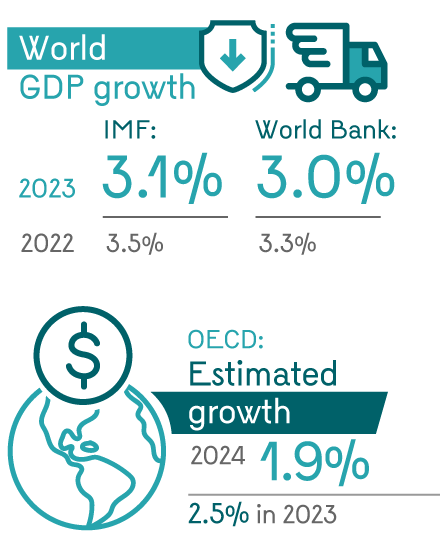
Economic Activity in Colombia
- According to the information from DANE (National Administrative Department of Statistics), the Colombian economic growth in 2023 was 0.6%, which was below all forecasts. This slowdown was caused by a combination of factors after recording all-time high growth in 2021 (10.7%) and 2022 (7.3%) that led the GDP to levels higher than those recorded before the pandemic.
- The reasons for this slowdown include contractionary monetary policy, moderation of expenditure towards levels compatible with the economy's productive capacity, and a lower dynamism of all types of credit. Likewise, the adjustment in public finances related to an increase in tax collection that caused a 4-point decrease in the General Government deficit, the contraction in civil works, and the uncertainty that affected investment decisions.
- The technical staff's growth projections foresee a moderate expansion in 2024 of around 0.8% and forecast that by 2025, the economy will enter a significant recovery phase, achieving an annual growth of 3.5%.
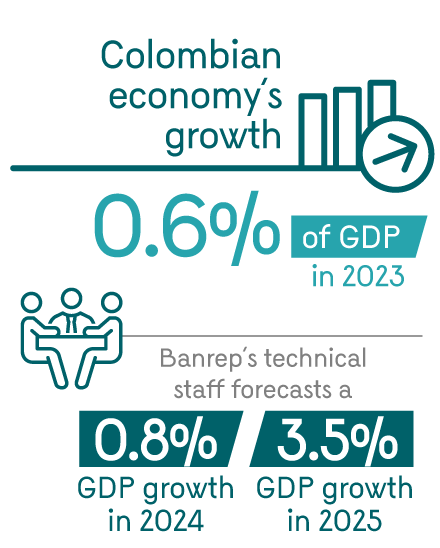
Employment
- The national unemployment rate decreased in 2023 to 10.4% at the end of the year, driven by the urban area. This was partially offset by the increase in unemployment in other municipalities and the rural area as of the third quarter.
- Salaried and formal employment was the most dynamic segment during 2023, with an increase of 2.9%. This was reflected in a decrease of the informality rate from 57.1% at the end of 2022 to 55.1% in December 2023, reaching all-time lows.
- Forecasts on the evolution of the unemployment rate for this year suggest that urban unemployment will average between 9.0% and 12.1%, with 10.5 % being the most likely value. In turn, the national unemployment rate could be between 9.3% and 12.4%, with 10.8% being the most likely value.

Inflation and Monetary Policy
- Annual consumer price inflation in Colombia peaked at 13.34% in March 2023, and as of April, it began a downward trend, reaching a level of 9.28% at the end of 2023. Thereby, the annual inflation rate returned to single-digit territory after 17 months of remaining above 10%.
- In January 2024, inflation continued to decline, at 8.35% yearly, below the technical staff's expectations. This meant a new and important step forward in the process of inflation convergence towards the target.
- With clear signs of lower inflationary pressures, the BDBR proceeded to cut the policy rate by 25 bps in each of its December and January sessions, bringing it to 12.75%.

Balance of Payments
- According to the information on the balance of payments the current account deficit during 2023 stood at 2.7% of GDP, 3.5 pp of GDP lower than that recorded in the same period of 2022 (6.2% of GDP). All components of the current account contributed to this correction.
- The largest adjustment occurred in the trade balance of goods, whose deficit was USD 5,310 million lower than a year ago. This is explained by the significant fall in imports, which exceeded the reduction in the value of exports.
- By 2024, Banco de la República's technical staff projects a current account deficit close to 3.0% of GDP in an environment of low economic growth and moderate recovery of domestic demand.
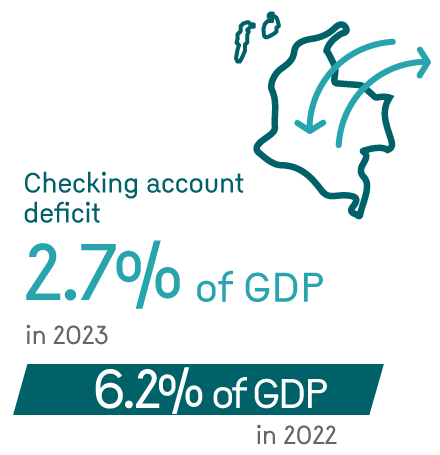
Public Finances
- The General Government (GG) deficit was reduced from 6.5% of GDP in 2022 to 2.5% in 2023. This important correction was possible due to the adjustment made in most of the components of this level of government, particularly in the Fuel Price Stabilization Fund (FEPC in Spanish) and in the Central National Government (CNG).
- In 2023, the CNG achieved a substantial adjustment to its finances due to the increased tax collections derived from the 2021 and 2022 tax reforms, the higher oil revenues, increased dividends from Ecopetrol, and increased profits from Banco de la República.
- By 2024, the CNG’s total and primary deficits are projected to widen by 5.3% and 0.9% of GDP, respectively. The tax revenues would increase from 16.6% of GDP in 2023 to 17.3% in 2024, reaching an all-time high.

Foreign Reserves
- Net foreign reserves at the end of 2023 totaled USD 59,608.3 m, i.e., an increase of USD 2,339 m during the year. The main factor explaining this increase is the interests received on investments. The return on foreign reserves during 2023, excluding the foreign exchange component, was 4.0% (USD 2,355 m).
- In the last months of the year, there was an increase in investment prices due to the reduction in short and medium-term interest rates in the main markets in which foreign reserves are invested.
- The indicators that evaluate foreign reserves suggest that as of December 2023, their level are adequate.
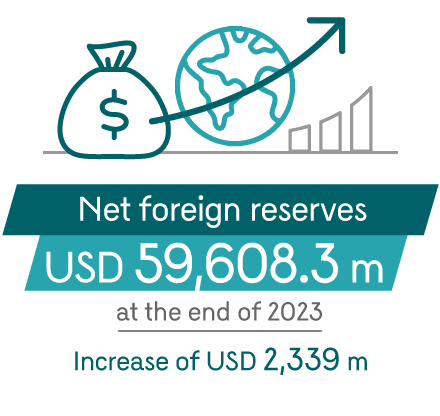
Profits of Banco de la República
- At the end of 2023, the Bank's profit was at an all-time high and amounted to COP 9,226 billion, resulting from revenues of COP 14,798 billion and expenses of COP 5,572 billion.
- Revenues observed in 2023 were COP 10,350 billion higher than in 2022, mainly due to the yield of foreign reserves. Expenses were COP 2,630 billion higher than those of the previous year, mainly due to the increase in the remuneration of the Colombian Government's deposits in Banrep, given the increases in the interest rate of the monetary policy and higher average balances.
- For 2024, profit is projected at COP 10,345 billion, higher than that observed for 2023. This result would be the product of revenues of COP 15,620 billion and expenses of COP 5,275 billion.























